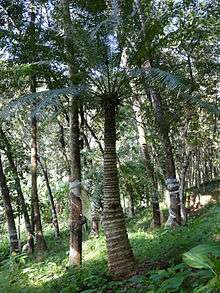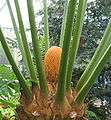Cycas circinalis
Cycas circinalis, also known as the queen sago, is a species of cycad known in the wild only from southern India. Cycas circinalis is the only gymnosperm species found among native Sri Lankan flora.
| Queen sago | |
|---|---|
 | |
| Cycas circinalis in Kerala | |
| Scientific classification | |
| Kingdom: | Plantae |
| Clade: | Tracheophytes |
| Division: | Cycadophyta |
| Class: | Cycadopsida |
| Order: | Cycadales |
| Family: | Cycadaceae |
| Genus: | Cycas |
| Species: | C. circinalis |
| Binomial name | |
| Cycas circinalis | |
Cultivation
The plant is widely cultivated in Hawaii, both for its appearance in landscape and interiors, and for cut foliage.[1] In the Philippines, it is locally known as patubo, pitogo or bitogo.
 Male cone, new
Male cone, new- Male cone, old
 Young shoots
Young shoots Seed
Seed Collected seeds
Collected seeds Young plant as seen in forest
Young plant as seen in forest Leaf
Leaf
Use as food
The seed is poisonous. The potent poison in the seeds is removed by soaking them in water. Water from the first seed-soaking will kill birds, goats, sheep and hogs. Water from the following soakings is said to be harmless. [Minimum of 5 Soakings needed to ensure the safety]
After the final soaking, the seeds are dried and ground into flour. The flour is used to make tortillas, tamales, soup and porridge.
Lytico-bodig disease
The plant was thought to be linked with the degenerative disease lytico-bodig on the island of Guam; however, the cycad native to Guam has since been recognised as a separate species, Cycas micronesica, by K.D. Hill in 1994.
Chemistry
Leaflets of C. circinalis contain biflavonoids such as (2S, 2′′S)-2,3,2′′,3′′-tetrahydro-4′,4′′′-di-O-methylamentoflavone (tetrahydroisoginkgetin).[2]
References
- Iwata, Ruth Y.; Rauch, Fred D. (October 1988). "King and Queen Sago". University of Hawaii. Retrieved September 24, 2012.
- Phytochemical Investigation of Cycas circinalis and Cycas revoluta Leaflets: Moderately Active Antibacterial Biflavonoids. Abeer Moawad, Mona Hetta, Jordan K. Zjawiony, Melissa R. Jacob, Mohamed Hifnawy, Jannie P. J. Marais and Daneel Ferreira, Planta Med., 2010, 76(8), pages 796-802, doi:10.1055/s-0029-1240743
